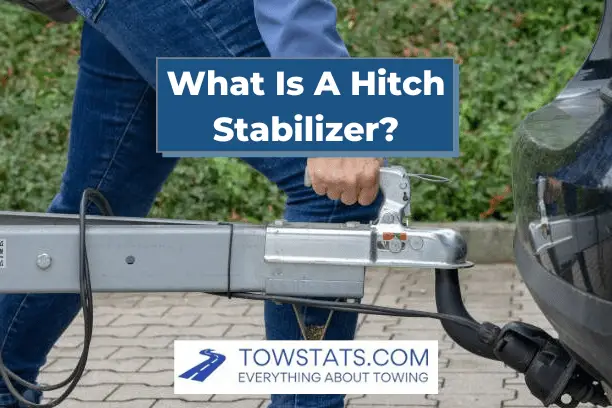Do you know what a hitch stabilizer is? If not, don’t worry, you’re not alone. A hitch stabilizer is a device that is used to keep a trailer or camper from bouncing around while it is being towed.
This can be especially important if you are towing something large or heavy, and is a key item that will help you quiet a trailer hitch.
Without a hitch stabilizer, the trailer could sway back and forth and cause damage to both the trailer and the tow vehicle.
In this guide, we’ll cover what a hitch stabilizer is and different ways to quiet your trailer hitch.
What Is A Hitch Stabilizer?
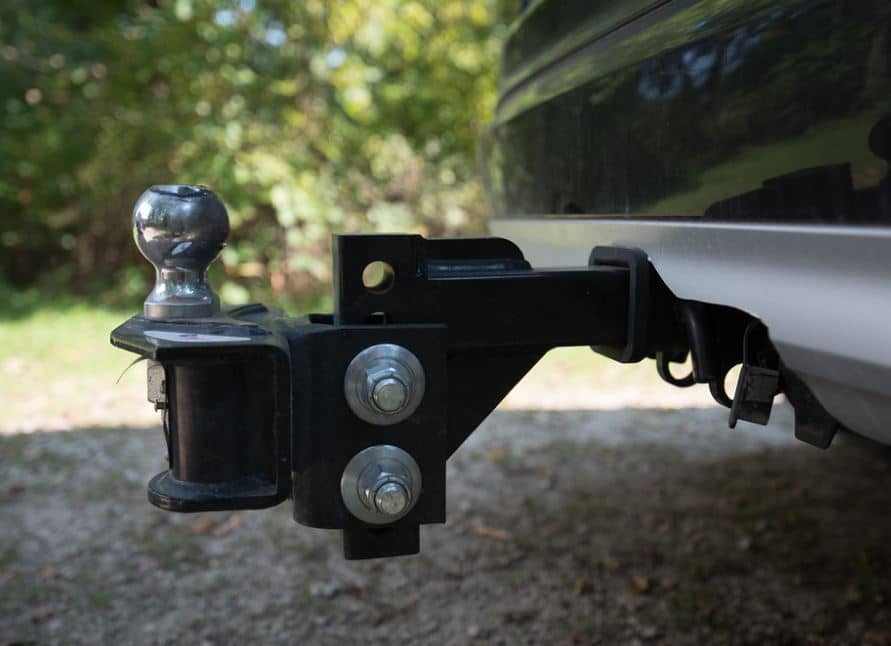
A hitch stabilizer, is a device that prevents rattling, rocking, wobbling, and other hitch movement on trailer ball mounts.
There are a few different types of hitch stabilizers which we’ll cover in today’s guide, and each of them have their own benefits.
You can use several of these together or individually as needed to address your problem and stabilize your towing ride.
Check out our guide to parts of a trailer hitch and how to hook up a trailer if you need a refresher before getting started.
How To Quiet A Trailer Hitch
Whether it’s movement or noise you’re trying to stop (or both), a hitch stabilizer is the thing you need.
As we mentioned earlier there are a few different types which we’ll cover, but first we need to get the basics straight.
Time needed: 1 hour
How To Quiet A Trailer Hitch
- Confirm Your Dimensions
Measure your receiver hitch size, trailer ball size, and receiver shank to ensure they are the correct sizes for each other.
- Load Your Trailer Properly
Confirm you are balancing your trailer load to avoid excess tongue weight, which can contribute to trailer instability.
- Choose Your Hitch Stabilizer Type
There are several types of hitch stabilizers available, and each resolve a different problem. Choose the best type for your situation.
- Install The Hitch Stabilizer
Always follow the manufacturer’s recommendations when installing a hitch stabilizer for best results.
Before You Begin
Now before you get amped up and go out to throw all the hitch stabilizers in your shopping cart, there are two key things you need to know: your dimensions and tongue weight.
Trailer Hitch & Equipment Dimensions
Measure your receiver hitch size, trailer ball size, and receiver shank to make sure they all fit together and are the proper size for each other.
If these are off or if you have any wiggle, there’s no hitch stabilization device that’s going to fix it.
Not to mention, it’s just unsafe to use trailering components that don’t fit properly together, so fix that first.
Tongue Weight
Are you loading your trailer properly?
If you’ve got a load imbalance on your trailer, you’ll still experience trailer sway and an uneven ride even with a hitch stabilizer installed.
Make sure you’re following the correct loading procedures before moving on to the next step.
Check out our guide on how to load a trailer for some easy tips.
Types Of Hitch Stabilizers
There are four main types of hitch stabilization devices, and each of them have a different method of operation.
Some address multiple issues with hitch stability, while others only address a single factor.
Assess what your situation is before purchasing any of these devices.
Anti-Rattle Clamps & Anti-Wobble Hitch Pins
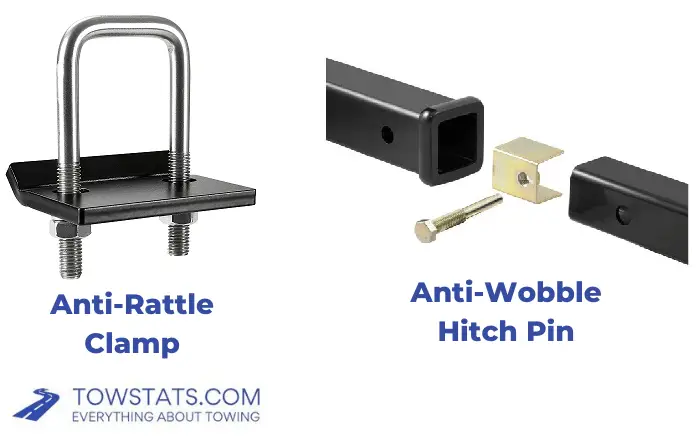
These are extremely simple devices that are cheap and easy to install, making them the most common way to quiet a trailer hitch.
Anti-rattle clamps (also known as hitch tighteners) are a U-bolt shaped item with a plate that goes underneath the ball mount shank to support it and tighten up the connection.
Anti-wobble hitch pins are a pin that connects on your ball mount shank like a normal pin does, except it also has an inner plate that reduces the available space inside the shank to reduce wobble.
Weight Distribution Hitches
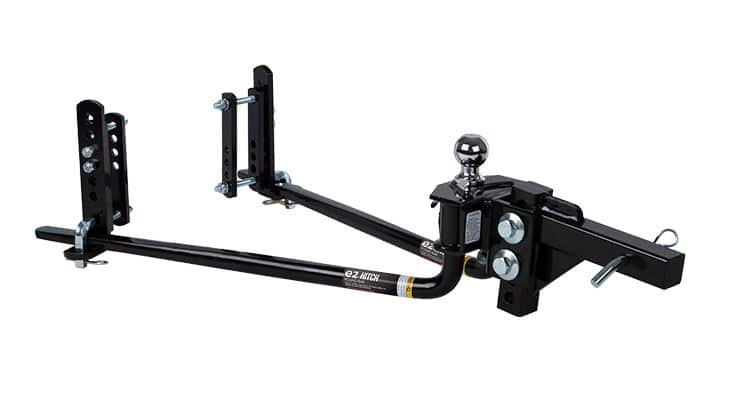
A weight distribution hitch manages extra tongue weight where the trailer coupler mounts on the trailer ball.
You’ll see weight distribution hitches used most often with travel trailers, but they can be used with other types also.
A weight distribution hitch uses two arms that push downward on the trailer tongue, allowing the weight to be “spread out” across the tow vehicle’s axles and helps keep the trailer level.
Read more: Do I Need A Weight Distribution Hitch?
Sway Control Units
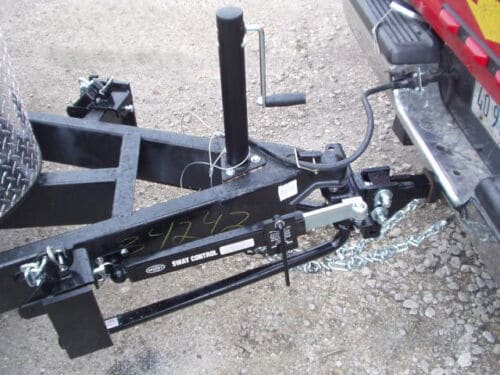
Sway control units are pretty self-explanatory: they control sway.
This is a straightforward piece of equipment that attaches between the trailer tongue and hitch to help keep sway down while you’re towing.
You can use sway control units in conjunction with a sway control ball mount, or you can use one along with a weight distribution hitch.
Cushion Hitches
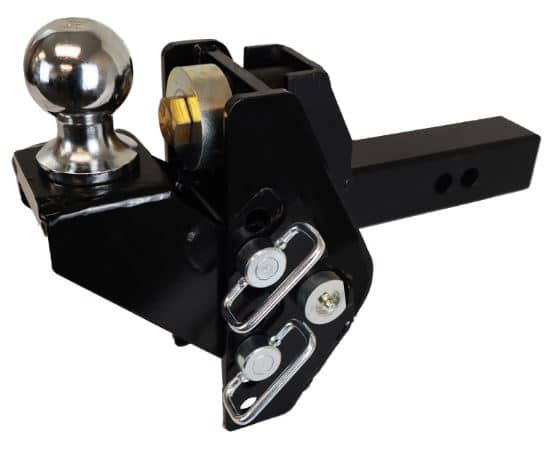
A cushion hitch gives a bit of vertical pivot to your ball mount, which in turn reduces vibration, rattling, jarring, and jerking of your trailer.
Some cushion hitches will use bearings, rubber inserts, or even airbags to dampen movement.
Cushion hitches are installed like other trailer accessories by inserting it into the receiver tube.
Some cushion hitches have the ability to support different ball mount sizes and heights, while others fit over an existing ball mount.
Wrapping Things Up
We hope this article has given you a good understanding of what a hitch stabilizer is and how it works.
There are a lot of different ways to stabilize your trailer and quiet your trailer hitch, so make sure you assess your needs before making a purchase.
Just be sure to double-check your equipment specs and trailer loading process before making a selection
As always, if you have any questions feel free to reach out to us and we’ll be happy to help.

